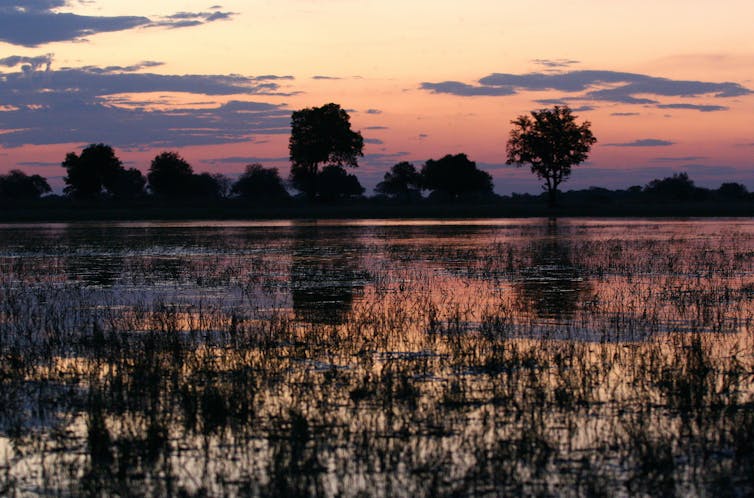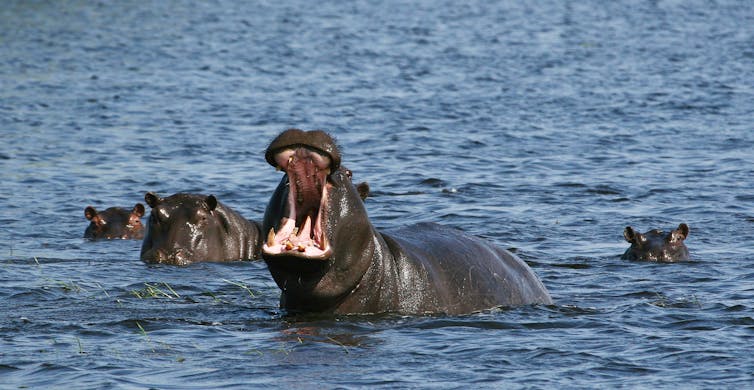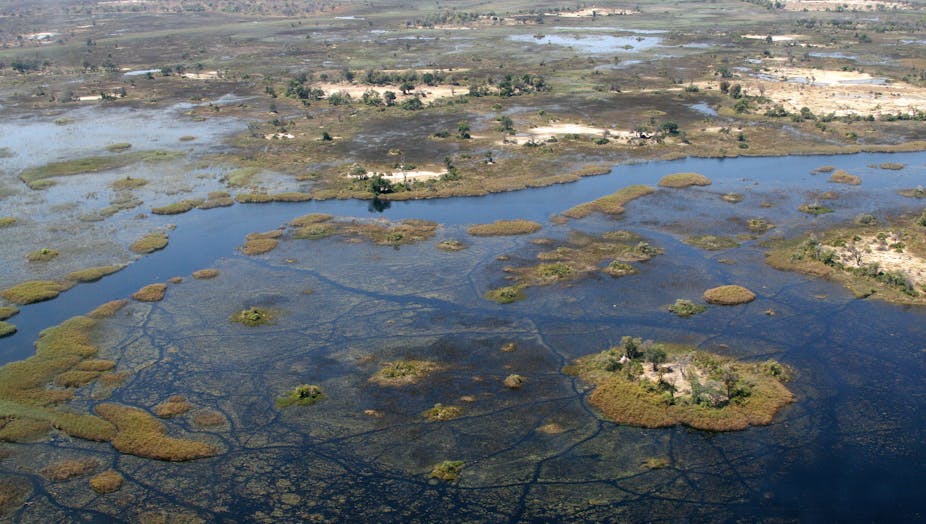The list of the natural world’s most extraordinary places, UNESCO’s World Heritage List, gained its 1,000th entry this week with the addition of the Okavango Delta in northern Botswana.
To be chosen for the UNESCO list a site must be deemed to have “outstanding universal value”. It is fitting that the delta should be such a landmark choice as it is quite simply unique: a wetland located in a desert, a delta that does not flow into the sea. This may sound improbable, but actually it provides an exceptional example of how biological, hydrological, biogeochemical and climatic processes have interacted to give us an ecosystem of outstanding importance and amazing biological diversity.
A desert, wet even in the dry season
The Okavango Delta is unusual in many respects. In October every year, rain falling in the highlands of Angola flows down the Cubango and Cuito rivers that, at the border between Angola and Namibia, join to form the Okavango River. This pulse of water, which accounts for over 60% of water entering the delta, flows slowly downstream over the course of four to seven months, reaching the northern part of the delta between February and May.
The pulse of water enters the delta through a broad valley in northern Botswana called the panhandle. Here the water is relatively deep and fast-flowing, cutting through the Kalahari sands, before a perpendicular geological fault caused by tectonic activity causes the water to spread slowly out into a fan, reaching the southern regions of the delta by August-September. In the southern hemisphere these are winter months, and in this particular region it is also the dry season. Therefore, the maximum flood extent actually occurs at the driest point of the year.
This pulse of water causes the size of the delta to fluctuate dramatically, approximately doubling its size from 6,000km2 to 12,000km2 every year during the dry season. Local rainfall during the summer months accounts for less than 40% of the delta’s river flow, but still plays an important role in influencing the extent of the area that’s flooded by the delta. Together they ensure local wildlife have water with which to thrive for much of the year, turning the delta into a huge green oasis that provides habitats on land and water for abundant plants and animals.

A persistent wetland freshwater oasis
Another remarkable feature of the delta is that, in the blazing heat of the desert, 98% of its water is lost through evaporation and transpiration (water taken up through plants and evaporating from their leaves). This is another paradox of the delta, that its waters remain fresh and not saline even with a strong sub-tropical sun. This is due to a complex set of interactions, only recently understood, which involve termites, trees and over 150,000 islands.
Most islands in the delta are thought to originate from tree saplings growing on termite mounds. As the trees grow, water and solutes are drawn up from the ground into plants and released through transpiration. This causes the water table to drop over time, which draws in water from the surrounding floodplains to replace it, and so keeps the area replenished with fresh water.
Salts concentrate under the islands creating zones of hyper-saline soils in which few organisms can survive, but as the concentrations of salts under the islands increases, the salts become sufficiently dense and heavy that they sink to the bottom, effectively ensuring a layer of fresh water above.
The dynamic and diverse delta
The Okavango Delta is one of Africa’s few remaining pristine wetlands, and since 1997 it has been classified as the world’s largest Wetland of International Importance. It has seen little damage from human activity, partly due to its nutrient-poor waters that result in low fish yields, and partly from a tourism policy that generates considerable income with minimal impact.

However, these long periods of available water and the delta’s nutrient-rich grasslands and floodplains have given rise to blossoming life, one Africa’s greatest concentrations of wildlife: the world’s largest population of elephants, hippos, and many threatened species such as the wild dog, black and white rhinos, and cheetahs. A great number of the 450 species of birds recorded on the delta are also globally threatened, such as slaty egrets and wattled cranes. This diversity is no accident; it is closely linked to the exceptional diversity of habitats caused by the unique dynamics of the pulse of floodwaters during the driest season.
Natural rainfall variation and the region’s internal hydrology mean there is always variation in the size and extent of the floodwaters. For example, after a period of contraction in the late 1990s-2000s the last few years have seen the delta flood to an extent not seen since the 1960s. It is perhaps inevitable that a warmer world will affect the region, and although the effects are not well understood, preliminary results suggest that floodwaters will decline.
But another clear and present danger, and one whose effects might be felt much sooner, is the threat posed to water and wildlife by the Botswanan government’s granting of 41 mineral licenses for diamonds, base metals, and oil in the Okavango Delta earlier this year. Even on the UNESCO list, nothing can be taken for granted.

